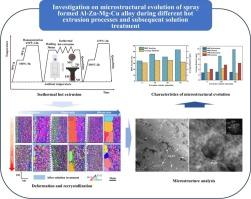喷射成形Al-Zn-Mg-Cu合金热挤压及固溶过程中组织演变的研究
IF 6.3
2区 材料科学
Q2 CHEMISTRY, PHYSICAL
引用次数: 0
摘要
研究了喷射成形Al-Zn-Mg-Cu合金在400℃和450℃下,以5 ~ 70 mm/min的挤压速度进行热挤压时的组织演变。然后对不同变形条件下的挤压棒进行350℃固溶处理2h和475℃固溶处理2h。揭示了温度和挤压速度对再结晶机理和异常晶粒长大的影响。结果表明:挤压杆表面以连续动态再结晶(CDRX)为主要动态再结晶机制,主要织构成分为黄铜{110}<;112>;中心区域的主要特征是纤维织构(<100>;和<;111>//ED),在晶界处观察到通过几何动态再结晶(GDRX)形成的少量细小再结晶晶粒。挤压杆表面形成了一层细晶层,其厚度主要受变形温度的影响。随着变形温度和挤压速度的升高,第二相颗粒的溶解导致钉钉阻力降低,导致挤压杆最外层形成ACG,逐渐发展为外围粗晶(PCG)。此外,PCG的形成机制主要受局部变形历史的影响。综合考虑喷射成形材料的热力学过程和钉钉效应,推荐最佳挤压参数为450℃,挤压速度为10 mm/min。本文章由计算机程序翻译,如有差异,请以英文原文为准。

Investigation on microstructural evolution of spray formed Al-Zn-Mg-Cu alloy during hot extrusion processes and subsequent solution treatment
The microstructural evolution of spray formed Al-Zn-Mg-Cu alloy was investigated during the hot extrusion with the extrusion speed of 5–70 mm/min at 400 ℃ and 450 ℃. Then, the extruded rods at different deformation conditions were subjected to solution treatment for 2 h at 350 ℃ and 2 h at 475 ℃. The influence of temperature and extrusion speed on the recrystallization mechanism and abnormal grain growth (AGG) has been unveiled. The results show that continuous dynamic recrystallization (CDRX) is the primary dynamic recrystallization (DRX) mechanism at the surface of the extrusion rod, and the main texture components were Brass {110} < 112 > . The center region is primarily characterized by a fiber texture (<100 > and <111 >//ED) and a limited number of fine recrystallized grains, formed through geometric dynamic recrystallization (GDRX), are observed at the grain boundaries. Furthermore, a fine-grained layer has been discovered on the extrusion rod surface and the thickness is primarily influenced by the deformation temperature. As the deformation temperature and extrusion speed increase, the dissolution of second phase particles leads to a reduction in pinning resistance, resulting in ACG at the outermost layer of the extruded rod and gradually developing into the peripheral coarse grain (PCG). In addition, the mechanism of PCG formation is primarily influenced by the history of local deformation. Considering the thermal-mechanical process and the pinning effect of the spray formed material, the optimal extrusion parameters are recommended to be at 450 ℃ with an extrusion speed of 10 mm/min.
求助全文
通过发布文献求助,成功后即可免费获取论文全文。
去求助
来源期刊

Journal of Alloys and Compounds
工程技术-材料科学:综合
CiteScore
11.10
自引率
14.50%
发文量
5146
审稿时长
67 days
期刊介绍:
The Journal of Alloys and Compounds is intended to serve as an international medium for the publication of work on solid materials comprising compounds as well as alloys. Its great strength lies in the diversity of discipline which it encompasses, drawing together results from materials science, solid-state chemistry and physics.
 求助内容:
求助内容: 应助结果提醒方式:
应助结果提醒方式:


